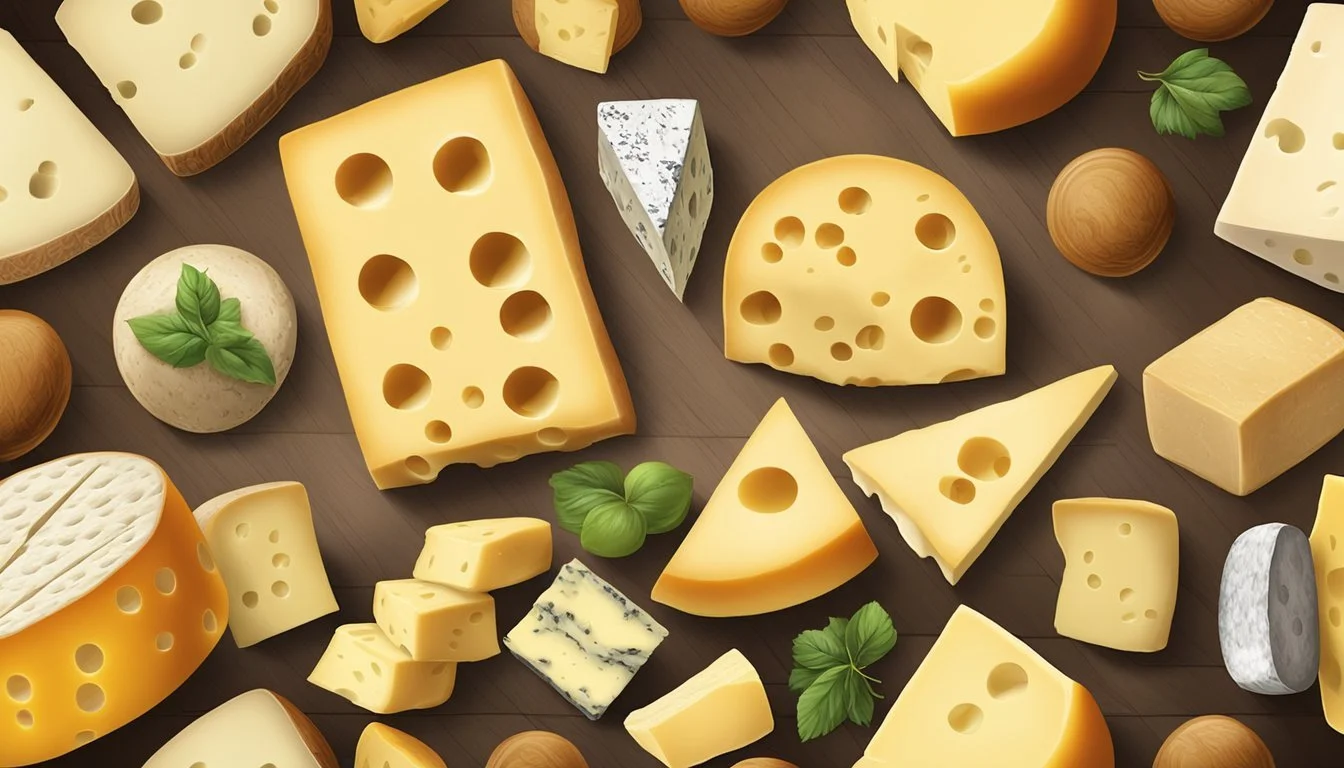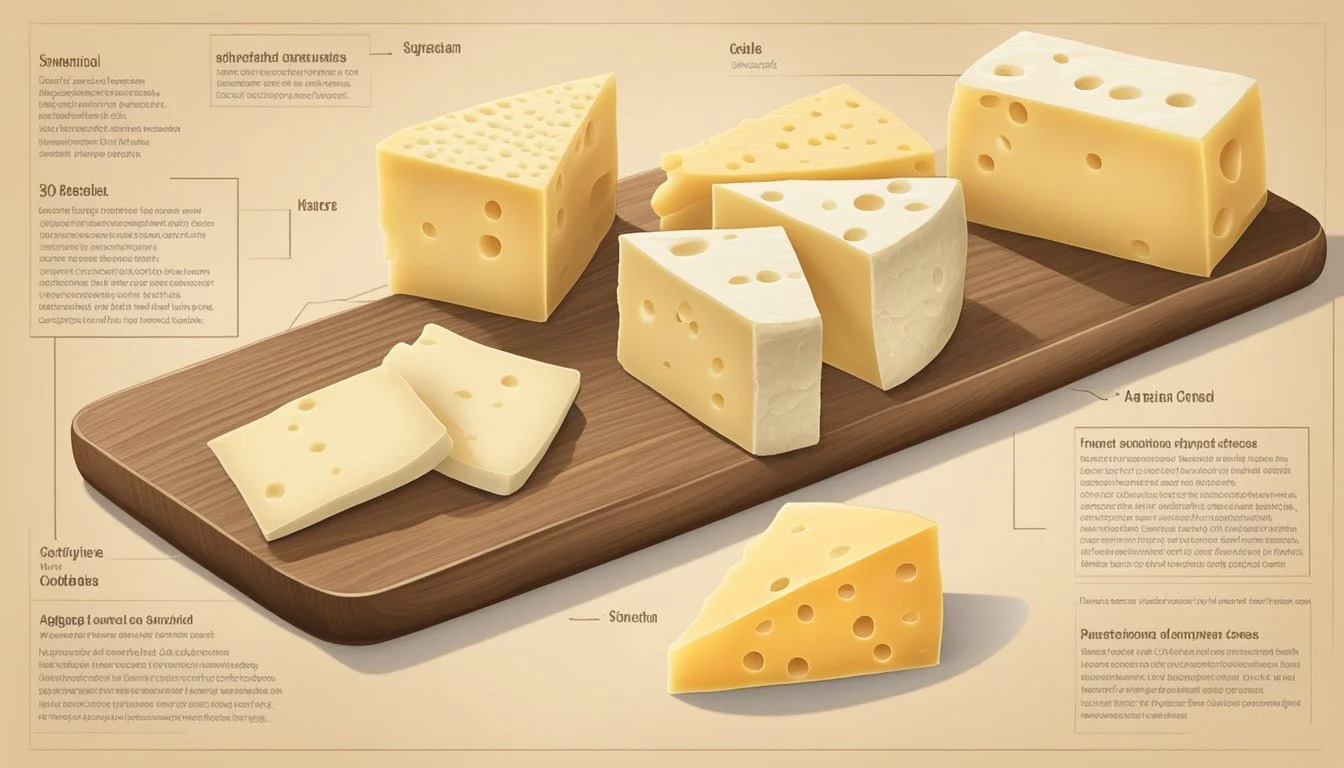Emmental Cheese Substitutes
Best Alternatives for Every Recipe
Looking for a substitute for Emmental cheese? You're in the right place. Gruyère is the best substitute for Emmental cheese, as it shares a similar nutty flavor and texture, making it a perfect replacement in most recipes. Additionally, Jarlsberg and French Comte are also excellent choices, offering their unique yet compatible flavors.
Gruyère provides a more complex taste with salty and earthy undertones. If you're after something with a bit more sweetness and a semi-soft texture, Jarlsberg is a great alternative. It has the characteristic holes of Emmental and works well in a variety of dishes.
French Comte's rich flavor closely resembles Gruyère, making it another viable option when you can't find Emmental. Other cheeses like Fontina and Raclette also offer suitable substitutes, ensuring you never have to compromise on taste or texture in your culinary creations.
Origins and Characteristics of Emmental Cheese
Emmental cheese's rich history and distinctive characteristics make it a staple in many cuisines. Originating from the Jura Massif region, it is celebrated for its nutty flavor and versatile culinary uses.
Historical Background
Emmental cheese, also known as Emmentaler, hails from the Emmental region in Switzerland, within the larger Jura Massif. The region is known for its lush pastures, providing the ideal environment for dairy farming. Cheese-making in this area dates back to the 13th century, with the first mentions of Emmental cheese appearing in 1293 in written records.
Originally, the cheese was produced using raw, unpasteurized cow’s milk, which contributed to its rich flavors. Over time, it has become one of Switzerland's most iconic cheeses, renowned for its traditional methods and quality control standards.
Texture and Flavor Profile
Emmental cheese boasts a medium-hard texture with characteristically large holes, or "eyes," formed during the fermentation process. This texture is achieved by using specific bacterial cultures that produce carbon dioxide, creating the holes.
The flavor profile of Emmental is complex and distinct. It carries a nutty flavor with a slight sweetness, often described as fruity. The maturation process, which can vary from a few months to several years, influences the cheese’s flavor intensity. Younger Emmental cheeses are milder, while aged varieties present a more pronounced, savory taste.
Common Uses in Cuisine
Emmental cheese is incredibly versatile in the culinary world. Its excellent melting properties make it a popular choice for dishes like fondue and raclette, traditional Swiss dishes. The cheese contributes a creamy, smooth texture that blends well with other ingredients.
In addition to fondue and raclette, Emmental is used in grilled cheese sandwiches, quiches, and various Swiss recipes. It is also a favored topping for casseroles and a key ingredient in soufflés. Emmental’s ability to complement a wide range of flavors makes it a staple in both home kitchens and gourmet restaurants.
Emmental Cheese in the Kitchen
Emmental cheese is known for its nutty taste and versatility in culinary applications. Its smooth melting properties make it a favorite in various traditional and modern recipes.
Classic Emmental Pairings
Emmental cheese pairs exceptionally well with nuts, fruits, and wine. A classic cheese board might feature Emmental alongside grapes, apples, and almonds.
Wine selections such as Riesling or Chardonnay complement Emmental’s flavors, enhancing a dining experience.
In a fondue, Emmental works perfectly with Gruyère, creating a creamy, rich dip for bread and vegetables. In sandwiches and paninis, its mild, nutty taste balances well with ham and mustard.
Incorporating Emmental in Recipes
Emmental cheese’s melting characteristics make it ideal for fondue, grilled cheese sandwiches, and macaroni and cheese. Its flavor profile enriches casseroles, gratins, and pasta dishes.
For pizza, adding Emmental alongside mozzarella creates a distinctive taste. Paninis featuring Emmental and roasted vegetables are both hearty and flavorful.
In baked pasta dishes, Emmental provides a creamy, savory layer that enhances the overall taste. Additionally, Emmental is excellent in soups, bringing a smooth texture and building depth in flavor complexity.
Guide to Emmental Cheese Substitutes
Choosing the right substitute for Emmental cheese hinges on texture, flavor, and melting properties. Various cheese options can effectively replace Emmental, each bringing unique characteristics to a dish.
Selecting the Right Substitute
When selecting a substitute, consider the specific needs of your recipe. For melted dishes, focus on cheeses that melt well. For raw cheese boards, prioritize flavor and texture. Gruyere is a favored choice for melting due to its creamy, nutty flavor and excellent meltability. Jarlsberg is another popular choice, offering holes similar to Emmental and a slightly sweet taste.
If seeking a milder cheese, Havarti and Fontina can provide a gentle profile. For recipes calling for a firmer texture, Gouda and Provolone can be utilized. Cheddar might be suitable for more robust flavors but keep its sharper taste in mind.
Best Cheese Substitutes for Emmental
Gruyere Cheese
Gruyere, often praised for its rich, nutty flavor, matches well with Emmental's melting capabilities. Use Gruyere in a 1:1 ratio for a nearly identical replacement in fondues or gratins.
Jarlsberg Cheese
Jarlsberg, hailing from Norway, resembles Emmental with its large holes and mild, slightly sweet taste. It’s versatile in both raw and cooked applications, making it a strong alternative.
Cheddar Cheese
For those favoring stronger flavors, cheddar provides a distinguished, tangy taste. Opt for young cheddar if a milder substitute is needed for melting.
Fontina Cheese
Fontina’s creamy texture and mild, earthy tones allow it to blend seamlessly within recipes that require smooth melting.
Provolone Cheese
Provolone offers a semi-hard texture and a mild, slightly tangy taste. It’s an excellent melting cheese, suited for dishes like sandwiches or baked recipes.
Havarti Cheese
Havarti’s buttery, creamy nature makes it a suitable choice for both raw and melted uses, closely aligning with the mildness of Emmental.
Gouda Cheese
Young Gouda can provide a similarly mild flavor with a smooth melting quality. This makes it a versatile choice for various culinary applications.
Exploring these options ensures that the desired balance of taste and texture matches your culinary creations. The right cheese substitute can maintain your dish's integrity while offering new, enjoyable dimensions.
Adapting Substitutes in Cooking
When substituting Emmental cheese, understanding the specific characteristics of each alternative can enhance various dishes like fondue, pasta, and salads. Careful selection ensures the best flavor and texture are achieved.
Cheese Substitutes in Hot Dishes
Gruyère is an excellent substitute in hot dishes. It melts smoothly, making it ideal for fondue and casseroles. Its nutty flavor enhances recipes like potato gratin, adding depth.
For pasta dishes, Jarlsberg is a dependable option. It has a mild, creamy texture that blends well without overpowering other ingredients. Use it in mac and cheese or lasagna.
French Comté adds a similar nutty profile to sauces. It melts evenly, perfect for a rich cheese sauce served over vegetables or in baked gratins. This adaptability ensures a seamless transition in recipes calling for Emmental.
Cheese Substitutes by Region
When substituting Emmental cheese, it is essential to consider regional alternatives that offer similar textures and flavors. This section explores substitutes from Europe, the Americas, and other regions to guide you in making the best selection for your culinary needs.
European Cheese Alternatives
Europe is renowned for its rich cheese-making traditions, providing several excellent substitutes for Emmental. In Switzerland, Gruyère cheese is a top choice. It has a nutty flavor and good melting qualities, making it suitable for fondues and gratins.
In France, Comté cheese presents a notable substitute. This cheese, produced in the Jura region, has a slightly sweet and nutty profile. Italian options include Parmesan cheese and Fontina, particularly from the Aosta Valley, offering distinct yet complementary tastes and textures. Norwegian Jarlsberg is another viable alternative, known for its mild, sweet flavor and holey texture, similar to Emmental.
Cheeses from the Americas
The Americas also offer wonderful alternatives to Emmental cheese. In the USA, Monterey Jack cheese is a versatile substitute. It has a creamy texture and mild flavor, making it suitable for various dishes.
Another American choice is Cheddar cheese. While it may be sharper than Emmental, aged Cheddar can produce a delightful contrast in recipes. Mexican Manchego cheese, crafted from cow's milk, is another option with a firm and slightly tangy taste that works well in grilled sandwiches and melted dishes.
Substitutes from Other Regions
Outside of Europe and the Americas, there are other regional cheeses worth considering. Brie cheese, although soft and creamy, can serve as a substitute due to its melting characteristics and mild taste.
For a unique twist, Indian Paneer can be used in dishes where melting is not crucial. Paneer has a firm texture that holds up well in heated applications.
These substitutes can help replicate the essential qualities of Emmental cheese, adapting traditional recipes to regional preferences and availability.
Nutritional Considerations and Availability
When choosing a substitute for Emmental cheese, it's essential to consider the nutritional content and availability of different cheese options. Specific cheeses like Gruyère, Jarlsberg, and Edam may offer similar flavors and textures, but can vary in nutritional profiles and ease of access at local supermarkets.
Comparing Nutritional Profiles
Emmental cheese is known for its nutty flavor and is made primarily from cow’s milk. It generally contains around 380-400 calories per 100 grams, with 27-30 grams of fat, 5-6 grams of carbohydrates, and 28-30 grams of protein.
Gruyère, a popular substitute, has a similar calorie count but slightly higher fat content at around 31 grams per 100 grams. Jarlsberg provides a comparable nutritional profile, with a bit more calcium and sometimes less fat. Edam cheese is a lower-fat option, offering around 25 grams of fat per 100 grams and similar protein levels.
Comparing these cheeses on a nutritional basis is crucial for those with dietary concerns. For example, those watching their fat intake may prefer Edam over Gruyère or Emmental, while those seeking higher calcium content might opt for Jarlsberg.
Finding Substitutes at Supermarkets
Gruyère and Jarlsberg are widely available at most supermarkets, often found in the specialty cheese section. Gruyère is especially common due to its popularity in dishes like fondue and quiche. Edam cheese is another widespread option, easily recognized by its red wax coating and often found near more common cheeses like cheddar or mozzarella.
Many supermarkets now offer private label versions of these substitutes, providing a more affordable choice without sacrificing quality. Additionally, online grocery retailers frequently stock these cheeses, making it convenient for those who prefer shopping from home.
Overall, finding suitable substitutes for Emmental cheese in local supermarkets is usually straightforward, with multiple options available based on nutritional preferences and availability.







